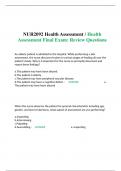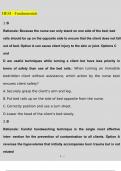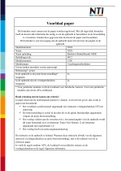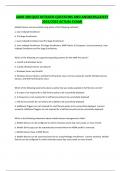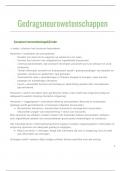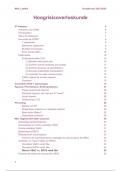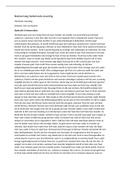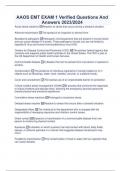lOMoARcPSD|8783322
NR601 Final Exam Study Guide
Primary Care of the Maturing and Aged Family Practicum (Chamberlain
University)
, lOMoARcPSD|8783322
Glucose metabolism disorders
Types of diabetes (prediabetes, type 1 and type 2)
Type 1: pancreases islet of the Langerhans- autoimmune. Type 1 diabetes most often occurs in
childhood and is characterized by low or absent levels of insulin, often resulting from an
autoimmune response leading to pancreatic beta-cell antibodies. Individuals with type 1 diabetes
require insulin therapy for survival. The onset of type 1 diabetes usually occurs in childhood,
with the major incidence of disease occurring in individuals less than 30 years old.
Type 2; Impaired insulin secretion; Type 2 diabetes usually occurs in adulthood and is thought to
be the result of insulin resistance and deficiency. This early understanding of diabetes has been
expanded by the discovery of other hormones involved in the regulation of glucose, including
insulin, glucagon, amylin, and incretin hormones. The onset of type 2 diabetes usually occurs
after age 40 years, with a mean age of 51 years. Age cannot be the only factor used to determine
the classification of diabetes, however, because type 1 or type 2 diabetes can occur at any age.
Risk factors: most common ethnicity
Type 1 diabetes primarily affects Caucasians.
Native Americans and Alaskan Natives have the highest prevalence of type 2 diabetes for both
men and women, with non-Hispanic African Americans and Hispanics next, followed by
Caucasians and Asians.
Type 2 diabetes affects men more frequently than women.
Diagnostic criteria
Diagnosis of type 2 diabetes mellitus: two fasting blood glucoses ≥126 mg/dL or two random
blood glucoses ≥200 mg/dL.
The criterion for the diagnosis of diabetes is either two fasting blood glucose readings with
results greater than or equal to 126 mg/dL or a random blood glucose reading greater than or
equal to 200 mg/dL if symptoms of diabetes are present.
In older adults, the glucose reading after a 2-hour oral glucose tolerance test (OGTT) rises more
rapidly than the fasting glucose Therefore, diabetes will be diagnosed sooner with the OGTT
than with fasting glucose alone.
Hemoglobin A1c (Hb A1c) measurement greater than or equal to 6.5 is indicative of type 2
diabetes. In the absence of unequivocal disease, the same test should be repeated at least once;
so, for example, if the Hb A1c is greater than or equal to 6.5, a second Hb A1c result should be
compared rather than comparing it to a fasting glucose level.
An advantage of using the Hb A1c is that fasting is not required and it is less effected by day-to-
day issues in the patient, such as illness or stress. An individual with a casual plasma glucose
level greater than or equal to 200 mg/dL, but without symptoms, should have fasting plasma
glucose, 2-hour OGTT, or Hb A1c measured. Fasting is defined as no caloric intake for at least 8
hours.
Initial treatment recommendations- first line treatment for each type
, lOMoARcPSD|8783322
Nonpharmacological therapy is the recommended first-line therapy for newly diagnosed patients
with mild-to-moderate hyperglycemia. Lifestyle modifications of weight loss and exercise are
particularly important in lowering Hb A1c. Although weight loss in frail elders is not
recommended due to the risk of sarcopenia, exercise of even a modest nature can be beneficial in
decreasing insulin resistance.
Metformin is also recommended for prevention or delay of type 2 diabetes in patients with a
BMI greater than or equal to 35 kg/m2 or anyone with a history of gestational diabetes or
patients with a rising Hb A1c in spite of lifestyle modifications.
Insulin should always be used as first-line therapy in type 1 diabetes or with patients who have
had diabetic ketoacidosis. A variety of regimens are used in the administration of insulin based
on the time of onset of action, time of peak effects, and the duration of action. Currently, the
most frequently used regimen is the basal/bolus insulin concept. This reflects the body’s
physiological insulin response. Basal insulins have an intermediate to long duration of action,
while bolus insulins, immediate or rapid in their action, provide postprandial coverage.
common medication side effects
Treatment goals for older adults (Kennedy table 14-2)
Healthy (few coexisting chronic Longer remaining life <7.5% 90–130 90–150 mg/ <140/9
illnesses, intact cognitive and functional expectancy (58 mg/dL (5.0– dL (5.0–8.3 mmHg
status) mmol/mol) 7.2 mmol/L) mmol/L)
Lipids: Statin unless contraindicated or
not tolerated
Complex/intermediate (multiple Intermediate remaining <8.0% 90–150 100–180 <140/9
coexisting chronic illnesses * or 2+ life expectancy, high (64 mg/dL (5.0– mg/ mmHg
instrumental ADL impairments or mild- treatment burden, mmol/mol) 8.3 mmol/L) dL (5.6–10.0
to-moderate cognitive impairment) hypoglycemia mmol/L)
vulnerability, fall risk
Lipids: Statin unless contraindicated or
not tolerated
Very complex/poor health (LTC or end- Limited remaining life <8.5%† 100–180 110–200 <150/9
stage chronic illnesses** or moderate- expectancy makes benefit (69 mg/dL (5.6– mg/dL (6.1– mmHg
to-severe cognitive impairment or 2+ uncertain mmol/mol) 10.0 11.1
ADL dependencies) mmol/L) mmol/L)
Lipids:
NR601 Final Exam Study Guide
Primary Care of the Maturing and Aged Family Practicum (Chamberlain
University)
, lOMoARcPSD|8783322
Glucose metabolism disorders
Types of diabetes (prediabetes, type 1 and type 2)
Type 1: pancreases islet of the Langerhans- autoimmune. Type 1 diabetes most often occurs in
childhood and is characterized by low or absent levels of insulin, often resulting from an
autoimmune response leading to pancreatic beta-cell antibodies. Individuals with type 1 diabetes
require insulin therapy for survival. The onset of type 1 diabetes usually occurs in childhood,
with the major incidence of disease occurring in individuals less than 30 years old.
Type 2; Impaired insulin secretion; Type 2 diabetes usually occurs in adulthood and is thought to
be the result of insulin resistance and deficiency. This early understanding of diabetes has been
expanded by the discovery of other hormones involved in the regulation of glucose, including
insulin, glucagon, amylin, and incretin hormones. The onset of type 2 diabetes usually occurs
after age 40 years, with a mean age of 51 years. Age cannot be the only factor used to determine
the classification of diabetes, however, because type 1 or type 2 diabetes can occur at any age.
Risk factors: most common ethnicity
Type 1 diabetes primarily affects Caucasians.
Native Americans and Alaskan Natives have the highest prevalence of type 2 diabetes for both
men and women, with non-Hispanic African Americans and Hispanics next, followed by
Caucasians and Asians.
Type 2 diabetes affects men more frequently than women.
Diagnostic criteria
Diagnosis of type 2 diabetes mellitus: two fasting blood glucoses ≥126 mg/dL or two random
blood glucoses ≥200 mg/dL.
The criterion for the diagnosis of diabetes is either two fasting blood glucose readings with
results greater than or equal to 126 mg/dL or a random blood glucose reading greater than or
equal to 200 mg/dL if symptoms of diabetes are present.
In older adults, the glucose reading after a 2-hour oral glucose tolerance test (OGTT) rises more
rapidly than the fasting glucose Therefore, diabetes will be diagnosed sooner with the OGTT
than with fasting glucose alone.
Hemoglobin A1c (Hb A1c) measurement greater than or equal to 6.5 is indicative of type 2
diabetes. In the absence of unequivocal disease, the same test should be repeated at least once;
so, for example, if the Hb A1c is greater than or equal to 6.5, a second Hb A1c result should be
compared rather than comparing it to a fasting glucose level.
An advantage of using the Hb A1c is that fasting is not required and it is less effected by day-to-
day issues in the patient, such as illness or stress. An individual with a casual plasma glucose
level greater than or equal to 200 mg/dL, but without symptoms, should have fasting plasma
glucose, 2-hour OGTT, or Hb A1c measured. Fasting is defined as no caloric intake for at least 8
hours.
Initial treatment recommendations- first line treatment for each type
, lOMoARcPSD|8783322
Nonpharmacological therapy is the recommended first-line therapy for newly diagnosed patients
with mild-to-moderate hyperglycemia. Lifestyle modifications of weight loss and exercise are
particularly important in lowering Hb A1c. Although weight loss in frail elders is not
recommended due to the risk of sarcopenia, exercise of even a modest nature can be beneficial in
decreasing insulin resistance.
Metformin is also recommended for prevention or delay of type 2 diabetes in patients with a
BMI greater than or equal to 35 kg/m2 or anyone with a history of gestational diabetes or
patients with a rising Hb A1c in spite of lifestyle modifications.
Insulin should always be used as first-line therapy in type 1 diabetes or with patients who have
had diabetic ketoacidosis. A variety of regimens are used in the administration of insulin based
on the time of onset of action, time of peak effects, and the duration of action. Currently, the
most frequently used regimen is the basal/bolus insulin concept. This reflects the body’s
physiological insulin response. Basal insulins have an intermediate to long duration of action,
while bolus insulins, immediate or rapid in their action, provide postprandial coverage.
common medication side effects
Treatment goals for older adults (Kennedy table 14-2)
Healthy (few coexisting chronic Longer remaining life <7.5% 90–130 90–150 mg/ <140/9
illnesses, intact cognitive and functional expectancy (58 mg/dL (5.0– dL (5.0–8.3 mmHg
status) mmol/mol) 7.2 mmol/L) mmol/L)
Lipids: Statin unless contraindicated or
not tolerated
Complex/intermediate (multiple Intermediate remaining <8.0% 90–150 100–180 <140/9
coexisting chronic illnesses * or 2+ life expectancy, high (64 mg/dL (5.0– mg/ mmHg
instrumental ADL impairments or mild- treatment burden, mmol/mol) 8.3 mmol/L) dL (5.6–10.0
to-moderate cognitive impairment) hypoglycemia mmol/L)
vulnerability, fall risk
Lipids: Statin unless contraindicated or
not tolerated
Very complex/poor health (LTC or end- Limited remaining life <8.5%† 100–180 110–200 <150/9
stage chronic illnesses** or moderate- expectancy makes benefit (69 mg/dL (5.6– mg/dL (6.1– mmHg
to-severe cognitive impairment or 2+ uncertain mmol/mol) 10.0 11.1
ADL dependencies) mmol/L) mmol/L)
Lipids:


